3
The Current Context
Transformative research in the geographical sciences arose during an era of strong federal and state investment in science and the parallel development of the higher education system in the United States. Since World War II, government involvement as a funder of and a market for research findings was instrumental in the development of new scientific and engineering knowledge in the geographical sciences (see Chapter 2). Interwoven among major economic downturns and international political conflicts, more than 60 years of funding for research represents the matrix in which the seeds of new ideas took root. While a counterfactual analysis designed to isolate the effects of six decades of support is impossible to conduct, the previous chapter traces the impact of five scientific endeavors undergirding the world as we know it today, enriched by transformative scientific discoveries in the geographical sciences.
Today’s call for increased support for transformative research is being made not only because of the practice it represents (e.g., how science is conducted; see Chapter 1), but also and importantly because today’s most challenging problems require approaches that are of a scale and scope reminiscent of the early post-war decades. In an age of scarce resources and shifting priorities, funders are being asked to choose among competing visions of the future; this includes everything from protecting existing program portfolios to having the license to redirect resources toward revolutionary solutions to problem solving (PCAST, 2012).
This chapter discusses the broader context of the study, and emphasizes how that context is quite different today than the context in which many of the transformative ideas discussed in Chapter 2 took root. Changing context provides an important ingredient to Chapter 4, where the committee considers possible recommendations. Thus, this chapter focuses in part on the importance of transformative research as a propellant of the U.S. economy at present. Tracing the intellectual development of the field of geographical sciences highlights examples of transformative knowledge that not only fostered innovations in the geographical sciences, but informed the broader scientific community through conceptual, methodological, and technology spillovers. Interdisciplinary by nature, the field of the geographical sciences embraces the physical and social sciences, and to a lesser extent the humanities, while utilizing methodological approaches that encompass the spectrum of practices from bench science to surveys, to textual analysis utilizing computer algorithms that are aimed at describing the content, structure, and meaning of the written word.
This chapter is divided into four sections. The first section examines the forces of change that are reshaping the current environment for research, including changes in funding for basic research and higher education. The second section examines changes in demographics that are altering the demand for higher education at both the
undergraduate and graduate levels. In the third section, developments in the international economy highlight the challenges facing the United States’ formerly unrivaled position in research and development (R&D). As the fourth section demonstrates, developing countries of the Global South are vigorously pursuing the technology frontier, utilizing capabilities fueled and funded by decades of strong national economic growth, and following an explicit strategy of catchup. The U.S. system of higher education no longer stands alone, if it ever did. China, India, Korea, and Singapore (to name a few of the less-developed countries that were among the first out of the starting gate) are building world-class educational systems with annual output rates in the tens of thousands of college graduates, trained on the latest technologies. Utilizing policies that favor import substitution, industrial targeting, and strategic infrastructure investments, ambitious countries are offering viable alternatives to the historic geographical concentration of global R&D functions.
In summary, the committee sees the U.S. research enterprise as currently facing four challenges:
-
Challenge 1: Federal R&D funding levels are likely to decline, or at least remain stable, in the near term.
Competition for scarce resources will pit existing programs and institutions against revolutionary developments.
- Challenge 2: After three decades of growth, state-level funding for R&D has stabilized and is in decline in many states.
- Challenge 3: In the near term, demographics point to a proportionately smaller cohort of individuals available to pursue undergraduate education. Pursuit of graduate education is responsive to levels of undergraduate debt, stagnant wages, and uncertainty over future investments in further education.
- Challenge 4: Developing countries are building educational systems capable of supplying the skilled labor that is required to attract R&D investments. The U.S. system of R&D and higher education now has rivals.
The four sections that follow discuss these challenges and provide the background for the fifth and final section. In that section, the committee explores the potential role of transformative research in responding to these challenges, and possibly helping to mitigate them. Thus, the committee sees transformative research, both broadly and in the geographical sciences in particular, as an evolutionary response to current developments.
It is also possible to take the view that transformation has always been characteristic of the U.S. research enterprise, and in Chapter 2 the committee documented the history of transformation in five areas of the geographical sciences. From this perspective, the committee sees a new call for transformative research as potentially countering the threat that these four challenges pose, through a systematic effort to rejuvenate a historic legacy.
THE AMERICAN SYSTEM OF KNOWLEDGE PRODUCTION: 50 YEARS IN THE MAKING
Transformative research is the hallmark of the interlinked R&D and higher-education systems in the United States (Council of Graduate Schools and Educational Testing Service, 2010). Set on a course initiated more than 50 years ago, the modern U.S. research enterprise arose from federal and private-sector investments in science and technology that were aimed at winning World War II (Adams, 2009; NSF, 2002). These efforts stimulated far-reaching experiments and unleashed new trajectories of technology development (Dosi, 1982) that resulted in military and commercial applications that have borne abundant fruit over the past six decades.
During and after the war, much of this research effort migrated toward universities (NRC, 2013) and
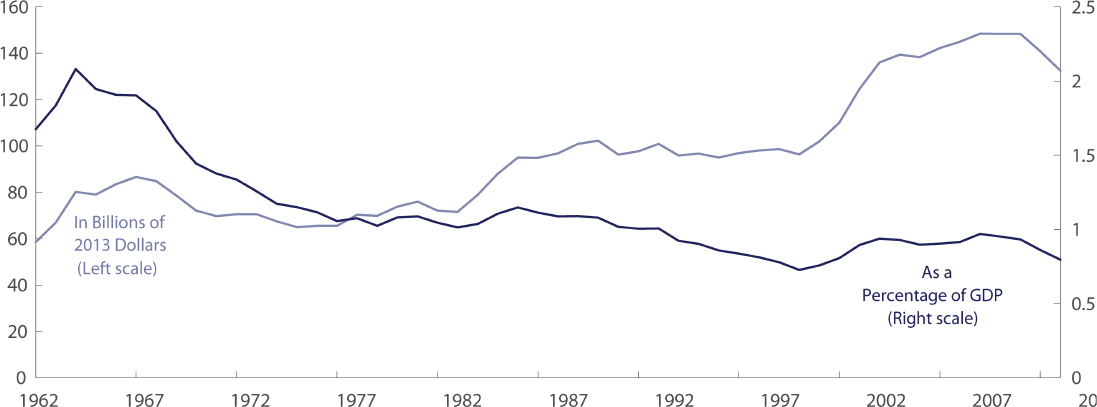
government-affiliated research centers and laboratories. Mounting massive research projects required a scientifically and technically trained workforce that had never before been necessary. During (and immediately after) World War II, research laboratories were established in key locations around the country (NRC, 2013). To serve the needs of the nation and the world, the military invested heavily in universities and research laboratories. Shortly after the war ended, many of these laboratories were recombined and often dispersed to new locations. This type of diffusion supported the development of strategic and innovative research capabilities across the U.S. research university enterprise (NRC, 2013) and led to the formation of industrial clusters and complexes that spawned autonomous innovations that extended well beyond the original stimulus.
With more than 100 Research I universities and another 99 colleges and technical schools designated as of high research intensity, as well as 41 federally funded R&D centers and 15 defense-sponsored, university-affiliated research centers (Carnegie Foundation, 1973), the nation’s innovative base fed off the human capital and ingenuity nurtured in these settings to produce new ideas and capabilities.
RESEARCH AND DEVELOPMENT FUNDING LEVELS IN DECLINE
The Federal Perspective
Calls for increasing the nation’s emphasis on transformative research activities, such as that from the National Science Board (NSB, 2007), are occurring simultaneously with an evident recent decline in federal funding for R&D, both in dollar terms and in percentage of Gross Domestic Product (GDP) (see Figure 3.1). Setting aside the counter-cyclical funding awarded under the American Recovery and Reinvestment Act of 2009, which blunted the worst effects of the recent recession, the U.S. Congressional Budget Office (CBO) estimates indicate that “since 2009, real federal R&D spending has declined by about 10 percent” (CBO, 2014, p. 10).

In recent decades, the federal role in funding R&D activity has diverged sharply from that of other countries around the world. As measured by R&D as a share of GDP, the United States is in a period of retrenchment, compared with earlier decades (see Figure 3.2). This shift has been accompanied by the rise of new competitors around the world that are devoting larger shares of national GDP to R&D activities. Starting at the end of the 1990s, the U.S. level of R&D intensity has been outpaced by many national economic growth trends, most notably in China, South Korea, and Taiwan (see Figure 3.2).
Since the 1980s, fluctuations in federal R&D levels of funding for academic disciplines reveal an increasing concentration of funding in medical science (see Figure 3.3). By contrast, the share of funding for the social sciences stayed miniscule and essentially flat. Although the geographical sciences have been effective at garnering support through collaboration with other disciplines, the fact remains that at NSF the “home” program lies within the Directorate for Social, Behavioral & Economic Sciences.
In past eras, federal-level retrenchment typically initiated reactions by universities, government research centers, and nonprofit research enterprises to shore up funding sources and reprogram activities to fill gaps in funding (Douglass, 2010). But the R&D shortfall of the past decade cannot be remediated by incremental adjustments to current operating budgets. A major factor in the growth of university spending for R&D is the cost of operations, which universities have increasingly had to cover from their own resources. The university’s share of R&D expenditures has grown to around 20 percent of the total R&D budget, up from 12 percent in the early 1970s (Howard and Laird, 2014; see Figure 3.4). Faculty startup packages and laboratory infrastructure are typically not covered by sponsored research funds and hence covering such gaps draws on university endowments and other discretionary sources of funds (Dorsey et al., 2009). This model is being called into question as universities

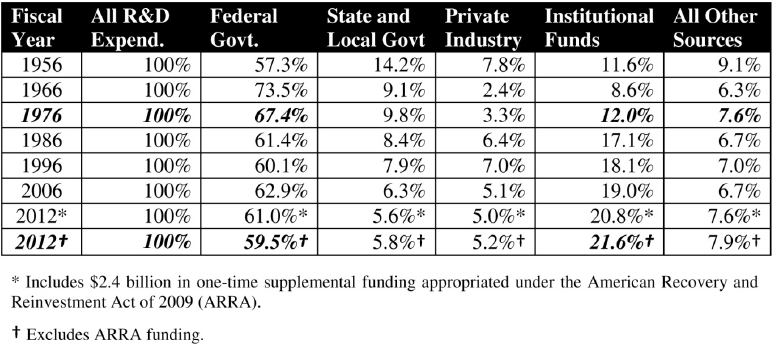
and colleges face constraints on the level of support they can expect to receive from other sources, including state government.
The State Perspective
Strengthening the nation’s capabilities to perform transformative research requires cooperation among three jurisdictions of government: local, state, and federal. While the federal government has traditionally provided funds to cover the cost of R&D, states have covered much of the cost of human capital formation by creating and maintaining a national system of higher education. Despite recent decreases in state funding, state-supported institutions still educate three-quarters of all students enrolled in higher education (Oliff et al., 2013).
The impact of state budget constraints on university operations is far reaching. State support for higher education is at a 30-year low. From a high in 1975 of 60 percent among states for higher education–related expenditures, these contributions were less than 40 percent by 2010. Moreover, student spending levels are down and tuition has risen sharply in public institutions (see Figures 3.5 and 3.6, respectively)
With the economy recovering slowly, some states continue to cut while others are beginning to replenish funding for higher education, but few expect a return to levels seen in the early 2000s (Oliff et al., 2013). A now familiar concern is the decreasing affordability of higher education. The lack of transparency evident in the budgets of higher education institutions is fueling public skepticism about the ability of university leaders to adequately address how rising costs are impacting families and students (Brand, 2014).
THE CHANGING DEMOGRAPHICS OF THE COLLEGE-BOUND POPULATION
The Production of Human Capital
The supply of and demand for higher education reveals looming deficits in student numbers at the undergraduate and graduate levels due to a weakening in the pipeline from high school through college to graduate school and the decreasing affordability of graduate education (Carnevale et al., 2010). Smaller cohorts, higher costs of education, and poorer labor-market outcomes are producing instability in the projected numbers of individuals ready for and available to pursue and sustain the system of higher education.
While the public concern about the affordability of higher education highlights the plight of undergraduates, the national research enterprise is fundamentally dependent on graduate students to fill classrooms, perform teaching duties, and staff research programs. Hence there is a link between an affordable undergraduate education and a pool of undergraduate candidates able to matriculate through graduate school.
The number of college-bound students is no longer inexhaustible; today, continuing increases in the number of students seeking a graduate degree are far from certain (see Figure 3.7). The falling number of graduate school enrollees is masked by the continuing flow of temporary residents seeking graduate degrees from U.S. universities (see Figure 3.8). To understand these trends requires dividing graduate degree–seeking students into two groups: U.S. citizens and permanent residents versus temporary residents. Seen in this way:
The Council of Graduate Schools (CGS) today reported a 1.0 percent increase in first-time enrollment between fall 2012 and fall 2013. Despite the gains in first-time enrollment, total graduate enrollment fell 0.2 percent between fall 2012 and fall 2013 following a 2.3 percent decline in the previous year. Total graduate enrollment was about 1.7 million students in fall 2013. While first-time enrollment of U.S. citizens and permanent residents shrank by 0.9 percent, the increase of 11.5 percent in first-time enrollment of temporary residents was enough to
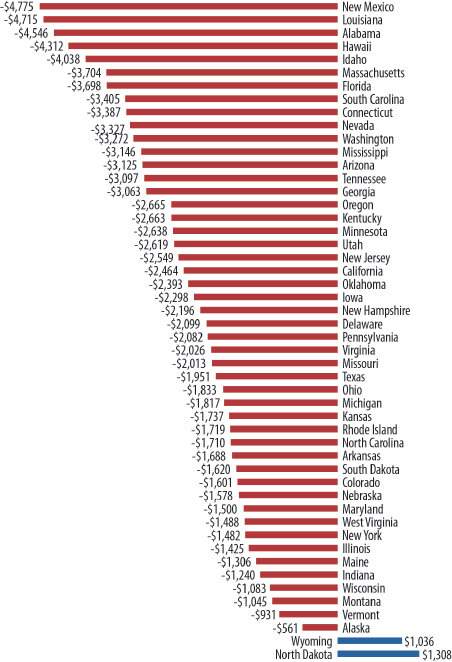
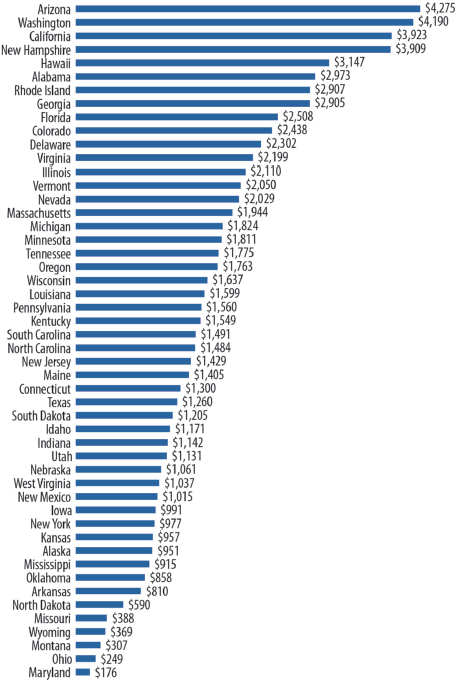
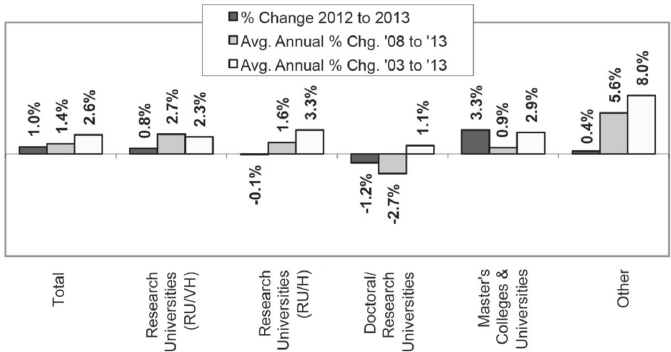
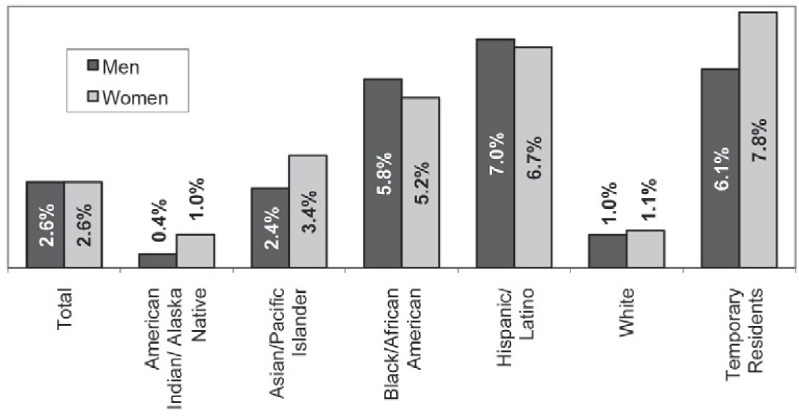
push the overall rate of change into positive territory. Temporary residents represented one in five new graduate students at U.S. programs in fall 2013 (Allum, 2014).
The sluggish trend in master’s degree and Ph.D. enrollments must be seen in light of similarly sluggish growth rates in occupations in higher education that require advanced degrees. In an assessment of Bureau of Labor Statistics (BLS) data on projected job openings from 2010 to 2020, the Council of Graduate Schools reports that job growth is expected to be insufficient to absorb the number of qualified candidates as projected over the decade (Allum, 2014). Academic careers are no longer as attractive as they once were, and universities are often accused of using part-time lecturing positions to substitute for high-cost, full-time, tenured positions. The Council’s analysis further suggests that the BLS figures undercount the number of existing graduate degrees in the labor market and hence the future demand for jobs by graduates over the decade (Bell, 2012).
COMPETITION IN THE GLOBAL MARKET FOR R&D AND HIGHER EDUCATION
Knowledgeable observers suggest that the United States is entering an era in which the economic stimuli accompanying prior investments in discovery are diminishing—an era that has been termed technological statis (The Economist, 2013a). This view is not held simply by popular writers and an occasional off-beat scholar, but peppers the conversations of policy economists and business leaders (Gordon, 2014; Howard and Laird, 2013; Porter and Rivkin, 2012; Summers, 2014; Summers and Balls, 2015). The range of causes aside, many economists have argued that the great U.S. innovation machine has reached middle age and is slowing relative to its younger and more nimble, newly industrializing counterparts (Summers and Balls, 2015; The Economist, 2013b). Calls to follow new directions are challenging the status quo, with beneficiaries of the existing system pressuring to stay the course while members of the next generation of scholars and practitioners are arguing for support of transformational practices and emergent modalities in science. Important influences include “the rise of the rest,” a phrase coined by the late Alice Amsden to recognize the role of the newly industrializing countries and their contributions to the world’s growing R&D capabilities (Amsden, 2011). She, along with others, speaks to the emergence
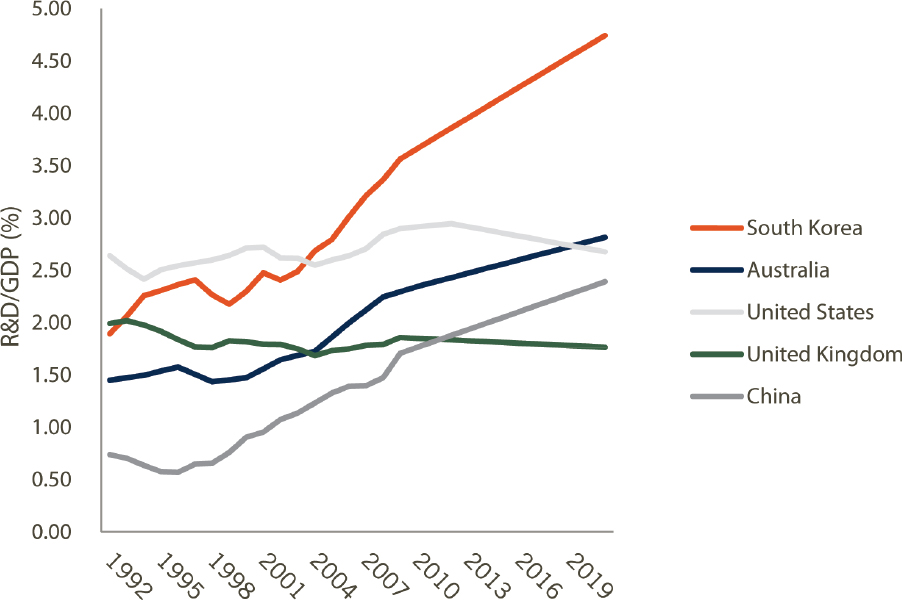
of geographic configurations of corporate R&D and the resulting supply chains that anchor a new geography of innovation founded on transformative research practices and new modalities of inquiry significantly beyond what was previously considered possible.
Evidence is mounting that the forces of globalization are enabling the formation of new sites of innovation, which are in turn pushing to equalize inventive ability between the Global North and the Global South (Matthews, 2014). Examples from China, India, and South Korea suggest countries of the Global South are applying lessons from macroeconomics, targeted industrial investment, venture financing, and human capital formation to forge inimitable expressions of autonomous innovation. With long histories of strong and tested state-led development policies and an unbridled quest for global leadership, countries with high and stable rates of economic growth have increasingly abundant concentrations of resources with which to compete, whether it be in the form of human resources or flows of capital (Amsden, 1992). These in turn are being targeted toward the design of systems capable of supporting transformative research (see Figure 3.9).
Nations around the world are building their own higher-education systems, offering incentives to retain the best students to fill classroom seats and benches in laboratories (Freeman, 2013a,b). This growth of university systems across the globe is yielding startling increases in the worldwide availability of skilled labor. Nations experiencing rapid rates of GDP growth over the past two decades have been investing in higher education and R&D operations. A comparison across countries in the expenditure for R&D tells a powerful story of increasing competitiveness of countries in the Global South. Freeman (2013a,b) shows that China and other developing countries have significantly increased the share of GDP that they spend on R&D. Countries of the Global South are also outcompeting industrialized countries in the production of academic publications. Freeman further shows that
China made a particularly large gain in its share of value-added activities in knowledge- and technology-intensive sectors, leading to large increases in exports of goods with high added value.
Thus, even if the current flow of foreign students into U.S. Ph.D. programs stays the same, the production of Ph.D.s globally is likely to grow. Moreover, should the flow of foreign students into U.S. graduate programs slow, empty seats will need to be filled by U.S.-born students.
The location of demand for talent is also shifting as corporations decouple laboratory and testing functions previously co-located in high-wage labor markets like the United States. Favorable circumstances abound offering support for and occasional subsidies to enhance the mobility of formerly “geographically sticky” laboratory operations (Markusen, 1996). In turn these same conditions are enabling new business supply chains to form in places like China, India, and Korea, where technical skills are less costly than in the United States.
Today, the United States is just one of many countries around the globe where research can be conducted (Bremmer, 2014; Porter and Rivkin, 2012). The sentinel case is in drug development. Michael Herper of Forbes reports that the development of a new drug costs upward of $5 billion (Herper, 2013). To reduce the cost and time to bring a product to market, U.S. and global drug manufacturers are engaging contract research organizations (CROs) in China and India to complete critical and costly phases of the drug-development process. Like turnkey microelectronics development of the 1970s to the 1990s, China has developed a world-class capacity to execute critical components of the drug-development system.
THE ROLE OF TRANSFORMATIVE RESEARCH
Over the past 60 years, the pursuit of new knowledge and the nature of scientific inquiry have changed fundamentally. The scientific community currently finds itself in an era of inquiry where the work of science is global in scale, multidisciplinary in scope, and unbounded by national geographies. Moreover, the types of problems underlying today’s research questions are of a profound and unique nature, calling for joint investigation and cooperation in line with causal forces and resulting consequences. These grand challenges—climate change, global food supplies, energy security, geopolitical conflict, scarcity of strategic minerals, deadly epidemics, and rapid urbanization toward a global urban future—all point toward a new modality of science. Leadership now will come from shifts in the model of R&D performance.
Like many endeavors, R&D is increasingly being judged on more than simple flows of inputs and outputs. Emphasis is now on outcomes and the consequences of investigative effort. This intersectionality represents new requirements and practices as innovators and early adopters, once juxtaposed in linear fashion, pursue the act of discovery through synergistic feedback among these groups.
Synergism is the new modality of discovery and it will serve to redefine the conceptual valuation of our approach from individual or comparative to collective advantage. The acts of problem identification and specification are growing in complexity as the scale and scope of challenges encompass far-reaching dimensionality. Reducing the spread of threats, such as the Ebola virus, necessitates boundary spanning as a core competency and starting condition; neither time nor resources are sufficient to wait out a process of scientific discovery advancing through stages of the unknown to the known.
Translating across disciplines will remain one of the core challenges in this era of synergistic science. Over the past 60 years, the United States has passed through distinct eras of discovery, each in their own way presenting challenges of translation and transformation. Now, the practice of translation and transformation must be a core tenet of future science. Moreover, the United States will be at an advantage as an English-speaking nation as long as English remains the international language of science.
Calls for the redesign of the national research enterprise often correlate with budgetary exigencies. Looking
back, however, other equally powerful forces have redefined the trajectory of innovation: wars, disasters, profound discoveries, new institutional practices, and social objectives such as expansion of medical sciences. Today’s call for transformative research can be understood as reflecting the convergence of several of these forces.
At the same time, we are living in a time of global unrest. Two decades of war and unresolved conflicts coincide with state-led development practices of a potentially new kind. Today, national governments are operating beyond their geographic borders in pursuit of national economic development objectives, including market and commodity resource domination. The growing number and scale of multibillion dollar sovereign wealth funds of countries such as China and Saudi Arabia, financed either from foreign exchange flows earned through the sale of goods and services or from petroleum dollar–denominated revenues received from high-priced barrels of oil, are erecting new patterns of relations that are challenging post-war era institutions such as the World Bank; arrangements emplaced after an era of global conflict and aimed with the goal of global stability and widespread progress. Secure in the belief that free trade aligned with democratic ideals would bring forth global economic growth and geopolitical stability, the liberal ideal represented in institutions dating from the Bretton Woods meetings are now open to at least some question. Much has occurred since the late 1940s. The premises underlying the original accord have shifted and the development challenges of Asia loom large in comparison with the rest of the world. Under the leadership of the Chinese, the Asian Infrastructure Investment Bank marks an effort to refashion global leadership roles and attendant development institutions to be more in line with 21st-century partnerships and development challenges. The signing on of Britain, France, Germany, Italy, and (reluctantly) the United States suggests that original signatories to the Bretton Woods Agreement also see that it is time for a change.
What of the governance of science in this emerging era? Through periods of peace and conflict, the pursuit of knowledge has remained inviolate, even as it has been refashioned to meet the ever-changing needs of society. Transformative research should be at the forefront of conversations today; as in the past, the language and understanding not only transcend conflict but often serve as the translation medium during periods of societal change.
To break with convention is not easy, and to confront unconventional forces of change is even more challenging. At an operational scale, proponents of resculpting the research enterprise take aim at past and current practices. These issues form just one layer of needed change that is structural in nature. Far deeper meaning is accompanying the message of change. The push for transformative research is not just a call in support of more innovation, nor is it simply a reaction to a shift in political will to finance basic research.
Accompanying transformations of the external environment are changes in scientific problems and their study. An emerging field of research on team science is beginning to yield an understanding of a set of key factors present in effective collaboration (Stokols et al., 2008). The prototypical model of science, one in which the research efforts of the lone scientist are enabled by and to some extent rewarded with research funding, is giving way to a model based around teams and small groups. While the lone-scientist model is not disappearing, it is evolving in a recognizable era of collective or team science in which problems under investigation are complex and system-wide in scale.
Support for team science is rising alongside calls for transformative research—in other words, a continuing search for game-changing practices and investigations of far-reaching ideas (Pennington et al., 2013). These two circumstances are converging and unfolding in a period of reduced expectations. Economic and political events serve as reminders that for the foreseeable future, global leadership is variable and fleeting and hence national policies to maintain and strengthen a nation’s current position necessitate deliberate and planned interventions.
A new design, ethos, and strategy are required at this moment. To this, new trajectories and imperatives must now be added to ensure that as the unsurpassed position that the United States has held since the 1950s melts into the global research enterprise, exploration and innovation are fostered in the interest of both material and intellectual transformation.












